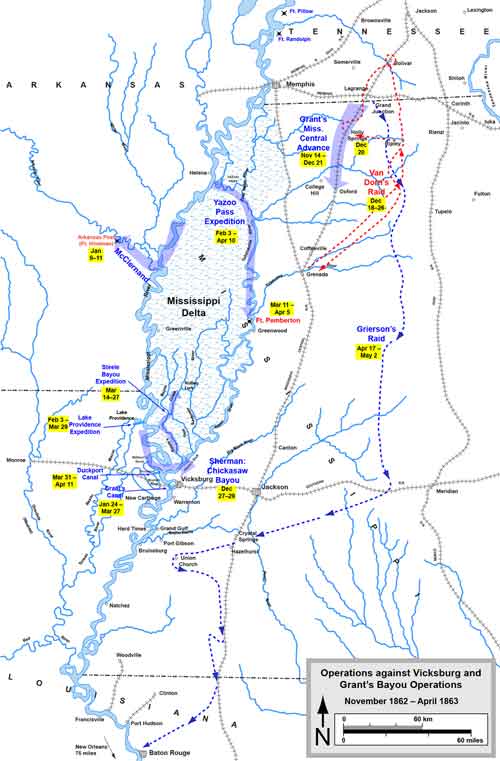
(This map tells it all. Vicksburg is in the middle- literally- just south of the great blob of the Mississippi Delta. Grant’s Bayou Operations are to the are to the west of the City, which commanded the Mississippi River. The trick was to get to the east and across the water so the Union could surround the City and bring it down, cut the South in half, and win the war in the West. Map drawn in Adobe Illustrator CS5 by Hal Jespersen, property USG).
I was looking around for something that would help me understand some details on the exploits of GG Uncle and Grandfather, the men who would become brother (in law) before this sweeping war was over. Two Irish lads caught up in something quite remarkable, the scope of which had never been seen in North America before, and the like of which had never been seen in this world.
The story is, perforce, jumbled. I was on the field at Raymond last month with a good pal- he is back there again, caring for some family business, and I feel a tug to go and see the places where my kin walked and got shot at.
So, having taken Uncle Patrick up the moment of his capture at Raymond, and having covered his escape from captivity before, now we are plowing the ground of the 72nd Ohio Volunteer Infantry, where Grandfather drove a team of horses when he was not raising a rifle against his future in-laws.
To further confound the narrative, I realized that the detailed genealogy that Mom had compiled in December of 1963 would be useful, since it would cover the terrain from Ireland to Nashville for Patrick, and from the Auld Sod to the valley of the Ohio River for Grandfather.
I despaired of that, since I have no idea where the ring-binder I have kept since childhood might be. It certainly is not in Arlington. But in the course of doing something else, I found the document on the external back-up drive of a computer I use at the farm. Huzzah! There is too much to discuss about all that- and who cares about the 1934 All-American Quarterback at the University of Pittsburgh, anyway? (Miller Munjas, btw, but there is no time for that now!)
Anyway, to help you through this chaotic passage, we are in November of 1862. Patrick is now on an intensively personal journey as a fugitive that we have discussed before, heading back to Nashville in a circuitous manner without sanction of the Confederate Army, and under wary gaze of occupying Federal forces.
James is with the 72nd OVI, and the unit history places them in Grant’s Central Mississippi Campaign, conducting operations on the Mississippi Central Railroad, November 2, 1862 to January 12, 1863. Then there is a period of duty at White’s Station through March 13, and then ordered to Memphis before being directed to proceed to Young’s Point, La.
As we discussed yesterday, it was all about Vicksburg. The map sums it all up. We will have to talk about Lt. Gen. John C. Pemberton presently, the man who commanded the garrison of that citadel town on the river. Grant’s operations to capture the city consist of a dizzying amalgamation of what we would call today joint operations- naval support, infantry maneuver, failed engineering initiatives of amazing scope and eleven distinct battles from December 26, 1862, to July 4, 1863.
Smart people who are not following their family around the various battlefields divide the campaign in two. The first part, which we are talking about today, is termed “Operations Against Vicksburg” (December 1862 — January 1863) and the second par t “Grant’s Operations Against Vicksburg” (March–July 1863).
Grant initially planned a two-pronged approach in which half of his army, under Tecumseh Sherman would advance to the Yazoo River and attempt to reach Vicksburg from the northeast, while Grant took the remainder of the army down the Mississippi Central Railroad. That is the strand where Grandfather James would have marched. Both of these initiatives failed. Grant conducted a number of “experiments” or expeditions that attempted to enable amphibious access to the Mississippi south of Vicksburg’s artillery batteries.
All five of these initiatives failed as well. Finally, Union gunboats and troop transport boats ran past the batteries at Vicksburg and met up with Grant’s men who had marched overland in Louisiana. That included the 72nd OVI, which was at Young’s Point, LA, a major Union supply depot and trans-shipping point throughout the Vicksburg Campaign.
On April 29 and April 30, 1863, Grant’s army crossed the Mississippi and landed at Bruinsburg, MS, marking the beginning of the Battle of Port Gibson. When his 17,000 troops began landing the sole witness to the invasion was a farmer who appeared too confused to flee. The port proved to have a good solid bank, and space for many boats. It was the largest amphibious operation in American military history until D-Day.
We will get to what happened after that presently, but here is how Grant put the accomplishment in his memoirs:
“When this was accomplished I felt a degree of relief scarcely ever equaled since. Vicksburg was not yet taken it is true…but, I was on dry ground on the same side of the river with the enemy.”
He was a stubborn son of a bitch, no kidding.
Copyright 2015 Vic Socota
www.vicsocotra.com
Twitter: @jayare303
